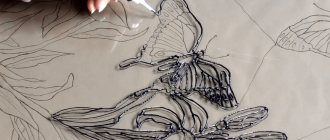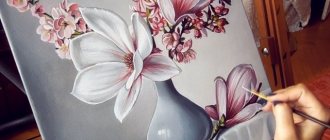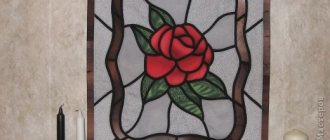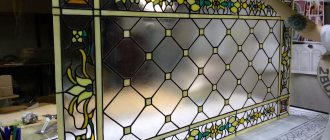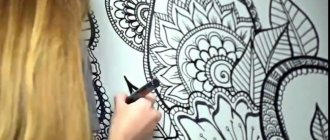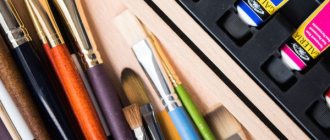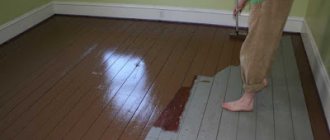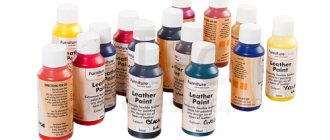So often, looking at the paintings of brilliant artists, many people begin to “itch” their hands. I would like to create a brilliant masterpiece of painting myself, albeit on the scale of my family. The soul requires beauty, and the hand requires canvas and brushes.
But, unfortunately, not everyone is given a natural gift for drawing. So what to do? I want to draw, but I also want to receive satisfaction from the work done and recognition from loved ones.
There is an exit! The modern market of paints and varnishes provides a huge selection of paints for creativity. You can easily find a product that will satisfy your desire to create masterpieces of painting.
How to prepare the surface?
Before applying stained glass paints to glass, mirrors or ceramics, the surface must be washed and degreased so that the paint adheres better, the adhesion to the glass is better, and... the stained glass paint does not peel off in the future.
Any detergent is suitable for washing. You can degrease it with alcohol or glass cleaner. The second option is used much more often, especially if the surface is large and flat.
You can degrease glass with glass cleaner.
Everyone knows that our skin secretes sebum, and on the palms of the hands and soles of the feet, it is produced especially intensively... By the way, this is why fingerprints are clearly visible on glass and metal. It is necessary to degrease the glass from sebum!
During operation, it is advisable not to touch the surface of the glass with your hands, so as not to leave fingerprints or palm prints. You can put, for example, a paper napkin under your hand. Very comfortably…
Advantages and disadvantages
Stained glass on glass is created quickly enough, and the work will not have any similar ones. The biggest advantage of such a painting will be its practicality. Painted stained glass windows, unlike soldered ones, can be used for large surfaces; moreover, they do not require cutting out individual pieces of glass and attaching them to the sketch. Therefore, when painting glass with acrylic paints, you get a durable and solid image. In addition, stained glass made with paints can be inserted into a double-glazed window, which will save much more heat than if soldered stained glass is inserted into them.
Related article: How to make a sliding door with your own hands
Glass painting fits much more easily into any apartment interior, while soldered stained glass windows require carefully selected furnishings. In addition, painted glass perfectly transmits light, creating a slight kaleidoscope effect.
How to paint with stained glass paints on glass: pipette or brush?
The beauty of stained glass paints is that they can be applied not only with a brush, but also with a pipette, which depends on the base of the material and the height of the paint.
With a pipette, for example, it is convenient to fill large spaces, and then use a brush to distribute the paint over the surface. At least that's how I work... I got the hang of it and the work goes faster and more interesting! The surface is even, smooth, just like real colored glass! But mostly, stained glass artists work with a brush.
In the photo I am pouring paint with a special pipette, but you can take a regular pipette from the pharmacy
It all depends on the final result that you want to see at the end of the work. It’s up to you to decide whether to choose a brush or a pipette... In any case, you need to try both to understand what works best for you!
If you are a beginner, then it will be useful for you to know that stained glass paints come in different bases. And before you go to the store and make a choice, it would be nice to figure out what and how.
Other types of stained glass
Stained glass on glass using paints is the easiest to do at home, but there are other types and methods of such work.
- classic soldered stained glass;
- Tiffany stained glass;
- fusing;
- frosted stained glass;
- Plastic Lead stained glass windows;
- stained glass windows made using casting technique;
- film stained glass window made using SGO technologies;
- faceted stained glass;
- bending;
- combined stained glass;
- stained glass window made by etching;
- laser engraving.
If you decide to decorate glass with stained glass, then before starting the main work, practice on small glasses, so to speak, get your hands on a little.
Is the circuit required or not?
Typically, classic painted stained glass or glass paintings have outlines. If your goal is beautiful, smooth murals, use raised paint or stained glass lead tape.
Remember: all contour lines must be closed. If there is a break somewhere in the outline, the colors will flow, mix, and this can ruin your work.
Most often they use a black outline or a tin color that imitates metal.
Unless, of course, this is a contourless technique, where the contour is not used to contain stained glass paint, but rather is of a decorative nature. In another article, you can read all about the most popular stained glass painting techniques
And of course, each manufacturer has its own contour paints in tubes of different colors. I especially like the ones that imitate silver or gold.
The golden outline looks great in subject paintings on glass
Be sure to let the relief outline dry for about 20 minutes before you start painting with stained glass paints! Take this into account! When working with stained glass paints, the sequence of actions one after another is important.
Just the facts
The name "stained glass" comes from the Latin word vitrum - "glass", which implies transparent patterns, paintings or drawings made on glass or colored glass.
Stained glass on glass dates back to ancient times. Most often it was used in temples and churches. In the churches of Germany and France, the first narrative stained glass windows were used, made in bizarre shapes, of different colors, and of quite large sizes. The stained glass windows depicted religious events, the life and everyday life of saints. This is the so-called painting on glass.
Stained glass appeared in Russia only in 1820 and they were first called transparent paintings. Just at this time, the revival of this art form began in Europe after a long period of oblivion.
How to paint with stained glass paints?
Pouring paint and filling in the elements in stained glass painting is perhaps the most interesting part. You need to start filling each sector from the core, gradually painting the areas next to the outline. At the same time, it is not advisable to “climb” onto the contour itself, otherwise the painting will look sloppy and not so impressive.
You can start learning to paint with large flower buds
The background can be painted last. But there are other options for painted glass paintings, where the main background consists of acrylic paint and... newspaper! This decorative design of a glass picture looks harmonious in an ensemble with stained glass varnish paints!
Especially for lovers of stained glass painting, I develop and record Master classes in video format. One of these lessons may be suitable even for beginners, since it is “chewed” in detail and will be understandable to everyone. It is also ideal for those who want to enjoy a quiet lesson as Art Therapy for relaxation and calm.
General information
In Russia, the art of stained glass painting began to develop in the 18th century.
For a long time, this process was held back by underdeveloped industry. It was only during the reign of Nicholas I that the first glass factory was built. In the 20th century there was a decline in interest in stained glass painting. Only at the end of the 20th century did vintage painting regain its former popularity. Many new technologies and modern materials have appeared. Vintage painting has been mastered not only by professional artists, but also by ordinary people with creative potential.
What can you paint using vintage painting?
Vintage painting can be used for finishing rooms, decorating furniture and various elements:
~ Glass in windows and doors
Stained glass windows look amazing. The sunlight passing through them creates a magical play of colors and fills the entire space with them. Doors with glass, decorated with vintage paintings, are very original and can stylize the room.
~ Interior partitions
Vintage painting will not increase their weight and will give them a special charm. You can make a separate backlight for them.
~ Kitchen facades
Modern paints allow you to paint on kitchen facades - they are not afraid of high humidity and temperature and are resistant to combustion products.
~ Photo frames and paintings
Stained glass paintings are very beautiful and look like real works of art.
~ A variety of serving utensils (all kinds of glasses, salad bowls, plates, etc.)
Such painted dishes immediately stand out and attract attention.
~ Vases, decanters and bottles
Even the most ordinary decanter with vintage painting can turn into a designer item.
~ Shades for various lighting fixtures - floor lamps, chandeliers and sconces. Such lighting fixtures will compare favorably with conventional ones.
~Mirrors. A mirror with vintage decorations will look simply luxurious.
How to correct defects and remove stained glass paints from glass?
A novice artist almost always encounters problems when working with stained glass paints: he accidentally “blurs out” more material, paints over the outline, creates bubbles... These defects need to be corrected immediately, before the paint dries.
Bubbles, for example, can be conveniently “expelled” to the contour, or “burst” with a needle or toothpick. And excess paint can be removed with a brush or cotton swab.
Paint that has leaked beyond the contour can be removed with a clean brush dipped in solvent.
It is convenient to clean an accidentally painted outline with a brush or stick dipped in solvent or water (depending on the base of the stained glass paint). Using a solvent can completely remove stained glass paints from glass before they dry.
Necessary tools for acrylic painting
If you don't know how to draw stained glass on glass, we will tell you. You need to prepare the following tools:
- the most suitable sketch made on paper;
- stained glass that is supposed to be painted;
- acrylic paints of pre-selected shades (it doesn’t matter which company you choose, the main thing is that at least 12 hours pass between applying layers, and 3-4 days before the first wash);
- solvent, it is advisable to choose one company with paints;
- ferrule;
- stained glass outline;
- cotton buds;
- toothpick or thin stick;
- synthetic brushes.
Once you have everything ready for work, you can proceed directly to creating your masterpiece.
6.How to dilute stained glass paints if they have thickened?
Remember: if your working material has thickened, you can only dilute it with a special thinner, preferably from the same company as the paints! Why?
If you dilute water-based stained glass paints with water, they will fade after drying. The same thing happens with organic paints. White Spirit “kills” varnish-based paints.
The wrong thinner will impair adhesion to the surface, reduce UV resistance, gloss and original shade.
Purity and transparency of color are the main indicators of stained glass paints
To ensure that the finished painting does not fade or become cloudy, and that the paints do not change their composition and properties, use special thinners designed for these purposes! Every paint manufacturer has them!
Many stained glass works have been ruined when artists did not dilute thickened stained glass paints correctly.
Materials for stained glass: film
Flexible, translucent film imitates stained glass of any complexity.
The coating can be glossy, matte, with colored streaks.
On the back of the film there are markings - cells. They are convenient for cutting out parts. And they don't get dirty from the marker.
Each detail of the stained glass window is hand-cut by hand. Then it is transferred to glass. First, glue the upper part without removing the protective paper completely, press it with a trowel and gradually, moving the protection, glue a section of the stained glass window.
The borders are closed with a flexible plastic bead with an adhesive backing. A real stained glass window is completely imitated, and no one will guess that the stained glass windows were assembled with their own hands.
The film lags behind the sun, but replacing it is not a problem. The materials are available and do not require special knowledge.
How to mix stained glass paints and get new shades?
Unfortunately, not all manufacturers of stained glass paints have such a large selection of paints as the French Pebeo Vitrail, for example. Don't despair, because paints can be mixed to get the desired shade!
To obtain new colors and shades, use a special container with indentations. Although you can get by with regular plastic bottle caps and other available containers.
Old cream jars make excellent containers for mixing paints.
Start mixing with a small amount of paint... it is important to remember that dark colors are easier to create than light colors. In any case, knowledge and skills come with practice. Try mixing and creating your own interesting colors and shades!
Why shouldn't you touch the surface of varnish-based paint?
If you have made your choice in favor of stained glass varnish paints , you need to remember one rule as an axiom: solvent-based stained glass paints take a long time to dry!
Any touch in the first 30-40 minutes will leave a fingerprint. Complete drying occurs after 8 hours or more (the manufacturer indicates the exact time on the jar). It is not recommended to force stained glass paints to dry, as this will cause them to lose their shine.
Also, keep your work to dry completely in a place where dust will not get in... otherwise you will end up with a “dusty decor” on the surface of the glass
